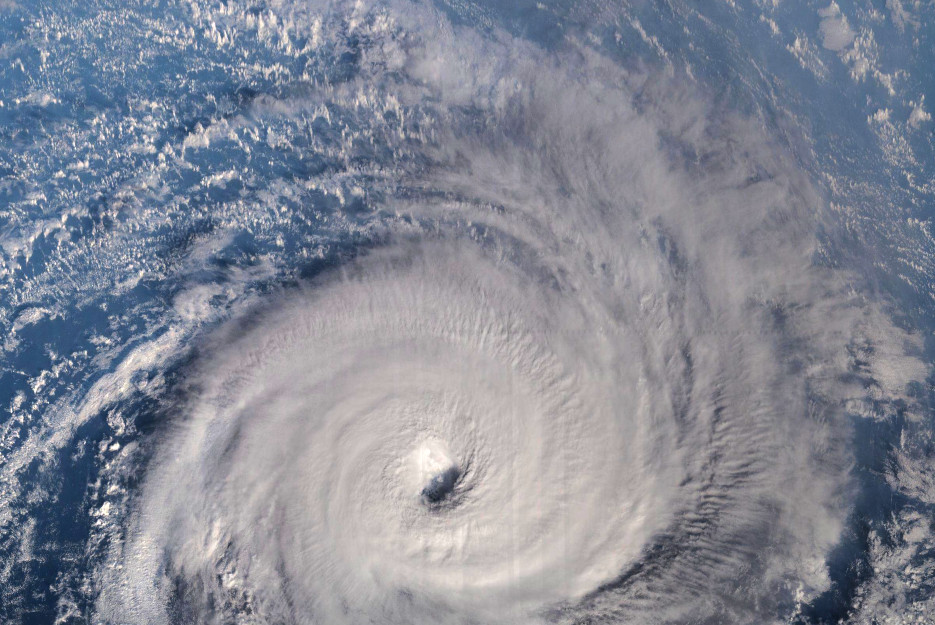One of the precursor projects for Tropical Weather Analytics’ Hurricane Hunter Satellites was the CyMISS (Tropical Cyclone intensity Measurements from the ISS) project which ran from 2014 to 2019. Funded by a series of grants from CASIS (Center for the Advancement of Science in Space) which manages the ISS US National Laboratory for NASA, CyMISS was performed by the science team at Visidyne (the corporate antecedent of Tropical Weather Analytics) for NASA’s Tropical Cyclone Experiment as part of NASA’s CEO (Crew Earth Observations) activities on the International Space Station. The goal of CyMISS was to acquire image sequences of intense tropical cyclones (TCs), such as hurricanes and typhoons, from the ISS using a specially designed photography protocol (see “The Cyclone Intensity Measurements from the ISS (CyMISS)”) to support the development of stereographic imaging techniques of these destructive storms. These techniques will allow the altitudes of the cloud tops near the eye of TCs to be precisely determined so that these TCs can be more accurately characterized compared to existing remote sensing methods (see “Using the Carnot Engine Model to Characterize Hurricanes from Orbit”). Because of how these stereo images are acquired, processed, and analyzed, the motion of cloud features can also be tracked to derive the winds in three dimensions including unique measurements of vertical winds – a vital input for accurately modelling the future track and intensity of TCs (see “The Impact of New Satellite Wind Measurements on Hurricane & Tropical Cyclone Forecasting”)
During the course of this five-year project, the CyMISS science team (which is now the TWA science team) amassed a large collection of storm images that we wish to share. One of the TCs observed in support of CyMISS by the crew of ISS Expedition 54 was the South Pacific storm, Tropical Cyclone Gita, observed on February 13 and 14, 2018.
February 13, 2018
For our first observation opportunity of Tropical Cyclone Gita, the crew of the ISS secured a sequence of 240 images during a four-minute observation session which started at 19:11:00 GMT on February 13, 2018 not long after this Category 3 storm (on the Saffir–Simpson scale) had passed the island nation of Fiji (see “ISS Daily Summary Report – 2/13/2018”). A sample image from this sequence is shown below. At this time, the eye of Tropical Cyclone Gita was straddling the International Dateline in the South Pacific with the eye located at about 21.0° S, 178.6° E. This was the first CyMISS observation session where the ISS crew used the improved Nikon D5 camera which had a larger focal plane array compared to the D4 model previously used resulting in a 12% improvement in the image pixel scale. Because of this upgraded camera and that the eye of Gita was situated only about 460 kilometers from the ground track of the ISS, these photographs provided among the highest resolution views of the eye of a TC acquired for the CyMISS program with a pixel footprint of about 80 by 130 meters.
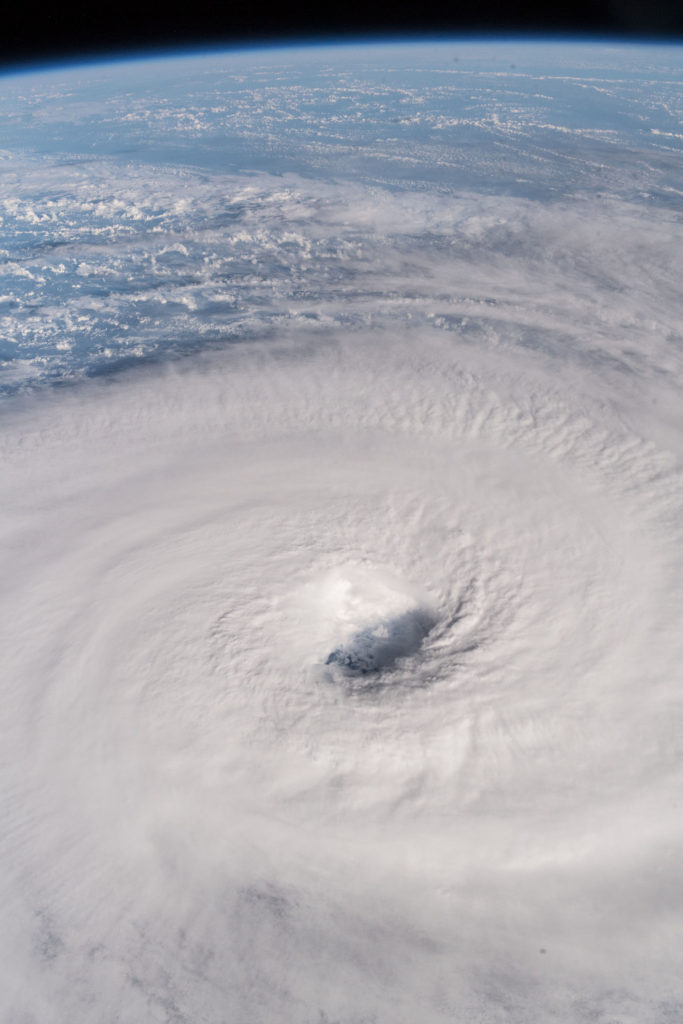
A synoptic 3D view created from the ISS photographs taken that day is shown below. In order to create the anaglyphic 3D image (left eye red, right eye blue), the individual photographs from the original image sequence were remapped to approximate an overhead view before various parts of the frames were stitched together into a synoptic 3D mosaic covering an area of approximately 1,500 by 1,000 kilometers. Note that this storm is rotating in a clockwise direction – the opposite direction to which we are accustomed to seeing in TCs in the northern hemisphere. A high-resolution version of this synoptic 3D mosaic with an image scale of about 600 meters/pixel can be viewed by clicking on the image below.
![]()
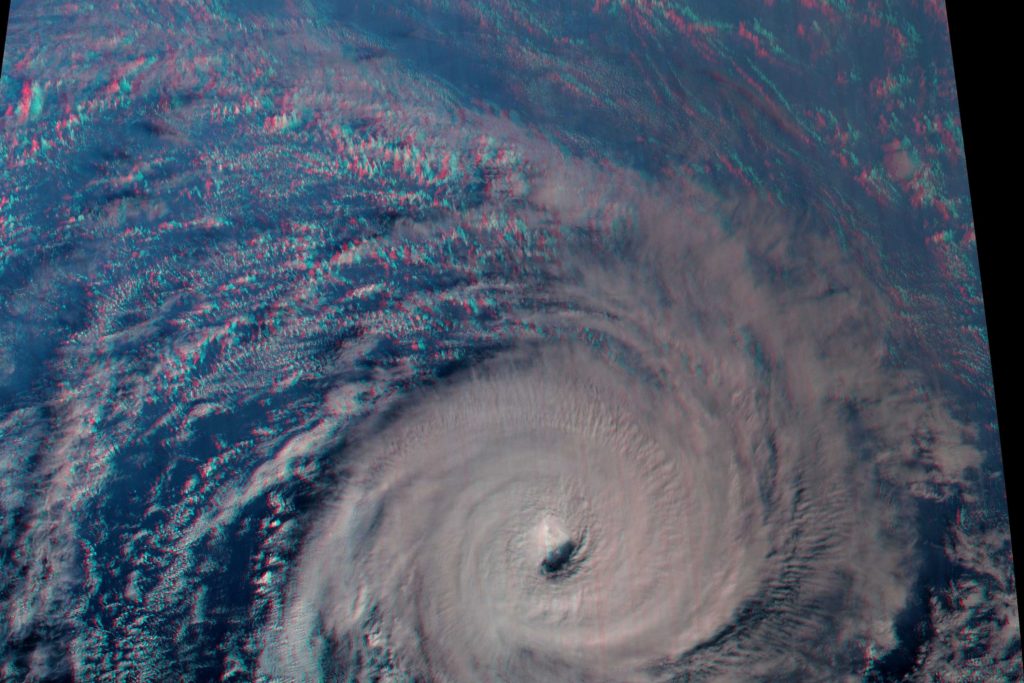
The close up 3D image shown below was created using a pair of close up photographs of the large, 80-kilometer eye of Tropical Cyclone Gita taken a few seconds apart around 19:13:15 GMT. Only the red channel of the original color images was used in order to cut through any atmospheric haze and maximize the visibility of the cloud features. These images were remapped to approximate an overhead view before being combined to create an anaglyphic 3D image. The resulting stereo view, which can be seen at full size with a scale of 100 meters/pixel by clicking on the image below, covers an area of 225 by 150 kilometers when the surface winds were estimated to be about 200 kph (125 mph).
![]()
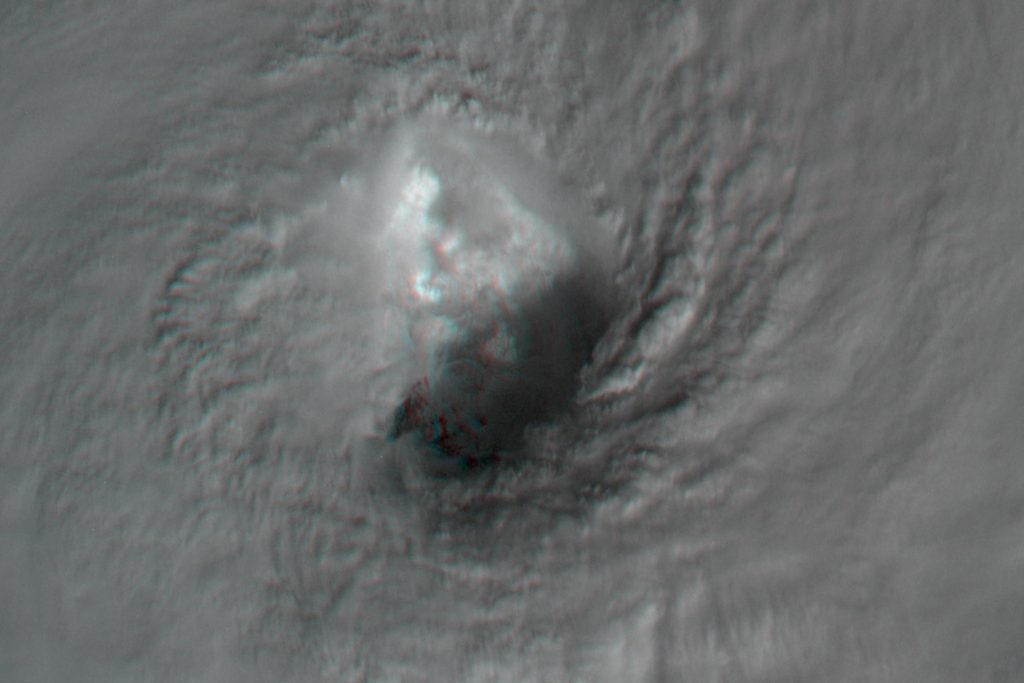
February 14, 2018
Because of the phasing of the ISS orbit and the motion of Tropical Cyclone Gita, the crew of the ISS was able to secure a second sequence of 240 images during a four-minute observation session which started at 19:55:00 GMT on February 14, 2018 – just over 24 hours after the previous day’s observations (see “ISS Daily Summary Report – 2/14/2018”). At this time, Gita was located at about 21.5° S, 174.9° E in the South Pacific about 390 kilometers west of its location when it was observed the previous day. The storm still was rated as a strong Category 3 storm on the Saffir–Simpson scale with sustained winds of about 193 kph (120 mph). Although the slant range from the ISS to the eye of the storm had increased to about 805 kilometers (compared to 630 kilometers the previous days), the resolution was still very good with a pixel footprint of 110 by 235 meters. A synoptic 3D view, created from the ISS photographs taken that day and covering an area of about 1,550 by 1,040 kilometers, is shown below. A high-resolution version of this anaglyphic stereo image with a scale of 775 meters/pixel can be viewed by clicking on the image below.
![]()

Immediately apparent in the new view from February 14 is that the 125-kilometer eye of Tropical Cyclone Gita was much larger than it had been 24 hours earlier and displayed much more internal structure. This structure is readily visible in the 3D close up view shown below. This stereo view, which can be seen at full size with a scale of 100 meters/pixel by clicking on the image below, covers an area of 300 by 200 kilometers.
![]()
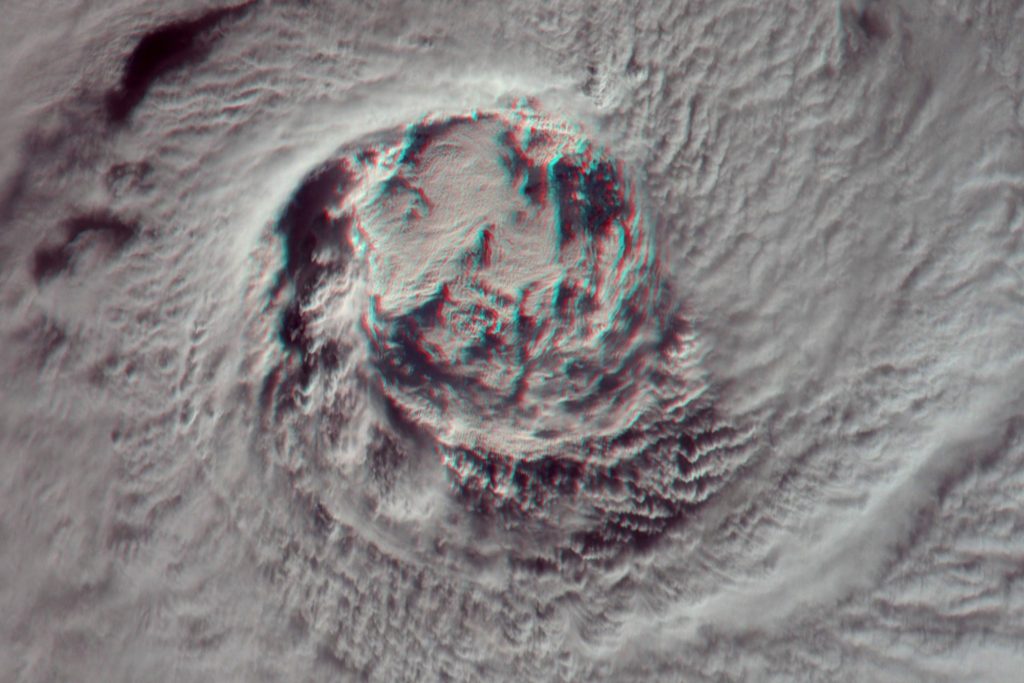
Related Reading
Andrew LePage, “The Hurricane Hunter Satellites”, Drew Ex Machina, May 15, 2022 [Post]
Drew LePage, “Using the Carnot Engine Model to Characterize Hurricanes from Orbit”, TWA Blog, July 23, 2022 [Post]
Drew LePage, “The Impact of New Satellite Wind Measurements on Hurricane & Tropical Cyclone Forecasting”, TWA Blog, January 15, 2023 [Post]
Paul Joss, “The Cyclone Intensity Measurements from the ISS (CyMISS)”, Space Station Research Explorer [Page]
Bill Keeter, “ISS Daily Summary Report – 2/14/2018”, ISS On-Orbit Status Report, February 14, 2018 [Post]
Jessica Scarfuto, “Tropical Cyclone in Sight: Tracking Hurricanes & Typhoons from Space”, Upward – Magazine of the ISS National Lab, March 26, 2018 [Post]
Andrew LePage, “Earth Day: Dramatic Weather in 3D Images from Space”, Space Station Explorers, April 21, 2018 [Post]
Paul Joss, “The Hurricane Hunter”, ISS360: The ISS National Lab Blog, April 26, 2018 [Post]

